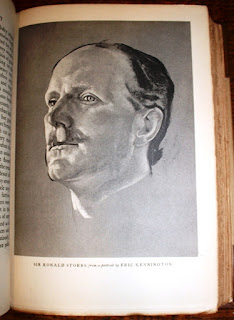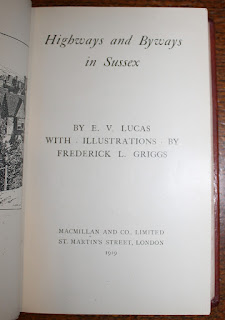Louis’88Books | J Allright | 9 Beaumaris Close | Andover | Hampshire
| SP10 2UB | United Kingdom é um livreiro-antiquário com largo historial na eBay.UK, que
nos apresenta as suas novidades em January Arrivals, com especial
ênfase nas Encadernações Artísticas/
Fine Bindings/Belles Reliures, com alguns exemplos de encadernações de
muito boa qualidade (algumas vezes superior à qualidade da obra em si…)
Vejamos então algumas dessas
encadernações:
T. E. Lawrence – Revolt in the Desert.
London: Jonathan Cape, 1927. First edition. Octavo, pp.446. Folding map plus
many illustrations. £225.00
Elegantly bound in brown half
morocco over cloth boards, spine gilt-lettered in six compartments with raised
bands, fore and tail edges uncut.
Textblock is clean. Overall a fine copy in a
handsome recent leather binding.
Thomas Edward Lawrence, CB, DSO (1888 -
1935), known professionally as T. E. Lawrence, was a British Army officer
renowned especially for his liaison role during the Sinai and Palestine
Campaign and the Arab Revolt against Ottoman Turkish rule of 1916 - 18.
The breadth and variety of his
activities and associations, and his ability to describe them vividly in
writing, earned him international fame as Lawrence of Arabia.
Revolt in the Desert was an abridged version
of Seven Pillars, which he began in 1926 and was published in March 1927 in
both limited and trade editions. He undertook a needed but reluctant publicity
exercise, which resulted in a best-seller.
Again he vowed not to take any fees from the
publication, partly to appease the subscribers to Seven Pillars who had paid
dearly for their editions. By the fourth reprint in 1927, the debt from Seven
Pillars was paid off. As Lawrence left for military service in India at the end
of 1926, he set up the Seven Pillars Trust with his friend D. G. Hogarth as a
trustee, in which he made over the copyright and any surplus income of Revolt
in the Desert. He later told Hogarth that he had made the Trust final, to save
myself the temptation of reviewing it, if Revolt turned out a best seller.
Charles-Alphonse
Dufresnoy (1611-1668) – THE ART OF
PAINTING BY C. A. DU FRESNOY WITH REMARKS. TRANSLATED INTO ENGLISH, WITH AN
ORIGINAL PREFACE, CONTAINING A PARALLEL BETWEEN PAINTING AND POETRY BY MR.
DRYDEN AS ALSO A SHORT ACCOUNT OF THE MOST EMINENT PAINTERS, BOTH ANCIENT AND
MODERN BY R.G. The Second Edition, Corrected,
and Enlarg'd.
£325.00
London: Printed for Bernard
Lintott, 1716. Small 8vo. pp. frontispiece, title, Epistle Dedicatory [8], “To
Mr Jervas” [6], lxviii, “A Table…” [4], 397, “Ancient Masters [7].
Engraved frontis. &
dedication headpiece by S.Gribelin. Woodcut ornaments & initials.
Recent calf with elaborate gilt decoration,
no title.
Second Corrected and Enlarged Edition of the
English Translation by John Dryden [1631-1700].
Dryden borrowed several months from his
translation of Virgil’s Aeneid to accomplish his prose translation of Du
Fresnoy’s De Arte Graphica (1668), to which he has added a prefatory essay
containing a ‘Parallel Between Painting and Poetry.
The translation was originally published in
1695. This second edition is believed to have been edited by painter Charles
Jervas, with the assistance of Alexander Pope, and includes a dedicatory poem
to Jervas from Pope. Pope greatly admired the translation as did Dr.
Johnson, who borrowed 400 quotations from it for his Dictionary.
Edward Verrall
Lucas – Highways & Byways in Sussex. Macmillan., 1919. £65.00
Good. Fourth reprint. Gilt titles to spine
with elaborate leather binding. 8x5. 444pp.
Frontis & many b/w illus by Frederick L.
Griggs, lacking the folding map.
William Henry
Scott – British Field Sports, Embracing
Practical Instructions in Shooting, Hunting, Coursing, Racing, Cocking,
Fishing, &c. With Observations on The Breaking and Training of Dogs and
Horses, Also The Management of Fowling Pieces, and All Other Sporting
Implements.
London: Sherwood, Neely and Jones, 1818. £165.00
Half Leather & Marbled Board.
First Edition. 9 x 5 Inch. 615pp + 34
plates present.
Engraved half-title and 34
engraved plates by Tookey, Davenport, Scott, Greig, Mutlow, Webb, Warren and
Ranson, after drawings by Barrenger, et al. xi, [1], [8], 615 pp.
Fred. Chas. FORBERG – MANUAL OF
CLASSICAL EROTOLOGY (De figuris Veneris). By Fred. Chas. Forbert. Latin Text and Literal English
Version. First Limited Numbered Edition. Two Volumes (complete). Manchester:
One Hundred Copies Privately Printed for Viscount Julian Smithson M. A. and
Friends, 1884.
£750.00
'Manchester: One Hundred Copies privately
printed for Viscount Julian Smithson M.A. and friends' 1884.
First edition of this important parallel
English, Latin and Greek version. It followed a poor piracy of 1882 badly
translated from Liseux's French edition of 1882.
Carrington gave a wry veiled account of its
publication in his 1902 catalogue, Forbidden Books:
“Were I a bookseller, I do not
think I should ever take the trouble to print such a book as I have now before
me.
Here is a Latin work, full of
notes, and bristling with Greek quotations. A most careful and masterly
translation has been placed opposite every page of the original text, and it
needs no literary critic to see that no one but a real classical scholar - an
old Oxford man-could ever have successfully struggled with such a task.
The two stout volumes have
evidently been printed on the Continent-and for very good and valid reasons, as
no English printer would dare to undertake such a work, - therefore each page
would have to be submitted to the translator, at least three or four times,
foreign compositors working mechanically.
Many months would thus pass in
wearisome proof-reading, and when at last the hundred copies are struck off,
and each man receives his due, what margin of profit awaits the silly
bookseller-publisher? He
is insulted in every way and laughed at if he dares to wonder that the British
Customs seize any copies.”
Carrington published some 300 titles (some
using his own name and others using false imprints, as here) mainly in Paris
where he lived from about 1894 until 1907, selling books from a shop in the
Faubourg Montmartre.
He notably printed several works by Oscar
Wilde when few other publishers would risk implication in Wilde's downfall and,
besides outright pornography, he printed a number of editions of classical and
oriental authors and important works on the psychology of sex.
In 1907 he was deported from France for
consistently publishing and selling literature "of a very obscene and
vulgar character". He continued his publishing business in Brussels before
returning to Paris in 1912. By 1920 Carrington was blind from the effects of
advanced syphilis, being admitted to the mental hospital at Ivry, south of
Paris, where he died in 1921. 2 vols, 8vo (210 × 140 mm), pp. xviii, 261,
[1]; [4], 250, [2].
Partially uncut pages with some closed tears
in early twentieth-century half red morocco, spines attractively gilt with
floral tools and onlays, top edge gilt.
Bookplate of Charles Reginald Dawes to front
paste down. An excellent set.
Numbered limited edition 67 of 100.
De figuris Veneris (On the figures of Venus)
is an anthology of ancient Greek and ancient Roman source texts on erotic
topics, discussed objectively and classified and grouped by subject matter.
It was first edited and published by the German
classicist Friedrich Karl Forberg in 1824 in Latin and Greek as critical
apparatus to his Antonii Panormitae Hermaphroditus, a reprint of
Hermaphroditus.
It was later published as a separate work and
translated into various languages. It concludes with a list of 90 sexual
positions.
De figuris Veneris has been
translated into English as Manual of classical erotology, into French as Manuel
d’érotologie classique by Alcide Bonneau (one French edition was illustrated by
Édouard-Henri Avril) and into Spanish as Manual de erótica clásica.
It contains: Foreward Of
Copulation; Of Pederastia; Of Irrumation; Of Masturbation; Of Cunnilingues; Of
Tribads;, Tribad Of Intercourse with Animals Of Spintrian Postures, Spintrian
Enumeration of the Erotic Postures.
John Milton – The Poetical Works of John Milton. London: Ward, Lock &
Co, 1880’s. £65.00
The complete poetical works of
John Milton. With an illustrated frontispiece, numerous vignette and several
full page illustrations throughout.
Edited, with a critical memoir of
Milton's lifeby William Michael Rossetti.
The work is undated.
John Milton was a prolific
seventeenth century poet. He wrote at a time of religious flux and political
upheaval, which is often reflected in his work.
He is best known for his epic blank verse
poem on the fall of man Paradise Lost.
In a full morocco binding with
gilt stamping to the spine and boards.
Externally, smart with a rubbing to the
extremities and the joints.
Pages are generally bright with some spots to
the first and last few pages, otherwise generally clean throughout.
Muitas outras obras podem ser
vistas e apreciadas nas páginas da loja virtual deste livreiro-antiquário, mas
hoje apenas quis apresentar algumas encadernações.
Aliás, mesmo noutras temáticas como no livro-antigo,
apresenta obras de maior raridade, mas aí talvez voltaremos num outro dia.
Veja-se este exemplo:
WILLIAM LAMBARDE –
A PERAMBULATION OF KENT: CONTEINING THE
DESCRIPTION, HYSTORIE, AND CUSTOMES OF THAT SHYRE. WRITTEN IN THE YEERE 1570. BY
WILLIAM LAMBARD OF LINCOLNE'S INN, GENT. London: Imprinted at London by Edm.
Bollifant, 1596. Second edition. 8vo. 7 ½ x 6 inches. [10] + 588 pp. + [5] +
[1]. (Pagination errors, p.35 is numbered 31, p.239, 139). £2,995.00
First published in the yeere 1576.
And now increased and altered after the
Authors own last Copie.
Illustrated with decorated title page, within
broad border, vignette at beginning of epistle and 2 maps, a full page woodcut
map, Anglia Heptarchia, with table of Saxon characters and exposition and a
folding woodcut map, 'A Carde of the Beacons, in Kent.'
Printed in black letter. Bound in limp vellum
over thin card with later chord added. Paper label to the spine.
A good copy of the book that is the first
English county history, here in the second and best edition (it was first
published 1570 and later editions appeared in 1640, 1656, 1826, 1970, etc.).
It is this work that inspired all subsequent
county histories. William Lambarde (1536-1601) was a lawyer and antiquary and a
personal consultant to Elizabeth I.
This second edition contains the fine map of
the beacon system for signalling danger from the coast to London, which was not
to reappear in subsequent editions.
'The description and historie of the shyre of
Kent' forms the greater part of the work and includes an account of its
geography and pre-Conquest history, a new section on the execution of justice,
a taxation summary by lathe, hundred and parish, a list of particular features
(e.g. fairs, poorhouses, etc.), an account of the see of Canterbury and
archbishops and a parish by parish account, with Thanet, the Goodwin Sands area
and the Cinque Ports grouped together at the beginning.
The final section lists the customs of Kent.
The text of all later editions is taken from
this Elizabethan black letter printing, one of the most desirable of Kentish
books.
Com este breve apontamento fica a
referência a mais uma livraria ainda não muito divulgada nestas páginas, mas
que merece uma visita.
Saudações bibliófilas.















































